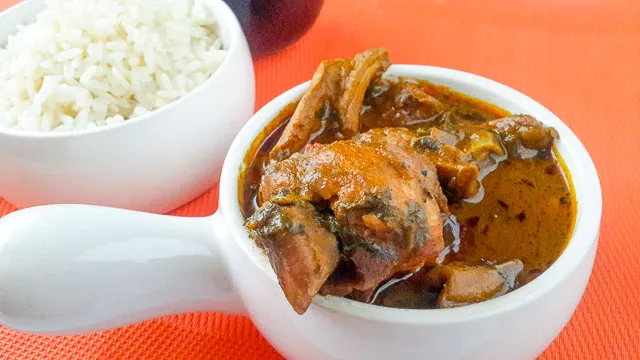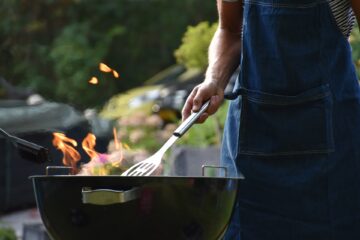Banga stew is the Igbo (a tribe in the southeastern part of Nigeria) version of Banga soup, a popular African delicacy usually prepared with oil palm fruit extract (locally known as Banga).
Originally from the Niger Delta region of Nigeria, Banga soup is enjoyed by other tribes in Nigeria, as well as in other African countries. As the dish was being adopted in other Nigerian tribes and African countries, the original Banga soup recipe was often altered to suit individual tribal preferences. Now, many tribes have their version of Banga soup, one of which is Banga stew, the Igbo version.
Banga stew is native to the Igbo tribe and is popularly known as “ofe akwu,” which means “palm nut soup” in the Igbo language. Different variations of palm nut soup are also enjoyed in many other African countries, including Cameroon and Ghana, where it is called “Mbanga.”
Unlike Banga soup which is usually paired with starch, Banga stew is generally served with boiled yam, boiled plantain, or white rice, but you can also enjoy it with starch, fufu, garri, or any swallow of your choice. This article will share three delicious Banga stew recipes you will most certainly love. But first, let us see how to prepare a simple Banga stew.
Banga Stew Recipes – How to Cook Banga Stew
Like other stews popularly eaten across different tribes, there are different Banga stew recipes in Nigeria. However, many people believe that what makes a great recipe is flexibility, that is, the ability to tweak a few things, and the meal will still come out delicious.
The availability of ingredients or your preferences will determine the Banga stew recipe you will use. Still, it takes a considerable amount of time and effort to prepare the ingredients, especially the palm fruit extract, if you are cooking it the traditional way.
Because many people do not want to go through the stress of boiling and pounding palm fruits before extracting the juice, they opt for the canned palm fruit extract commonly sold in supermarkets. However, Banga stew lovers claim that the canned palm fruit extract is factory manufactured and is less flavorful and tasty than the manually prepared palm fruit extract.
So, I will show you how to extract palm fruit juice (for those who want to extract their palm fruit juice manually). But if you would rather use the store-bought palm fruit extract, it works well too.
Banga Stew Recipes – Tips and Ingredients for Banga Stew That You’ll Love
Course: MainCuisine: AfricanDifficulty: Medium4
servings2
hours30
minutes40
minutes440
kcalI will show you how to extract palm fruit juice (for those who want to extract their palm fruit juice manually). But if you would rather use the store-bought palm fruit extract, it works well too.
Ingredients
9-10 cups of Palm fruit or 1 large tin of canned palm fruit extract.
1 kg of beef (cut into pieces)
500g of smoked or fresh fish (preferably mackerel)
2 cups of sliced fluted pumpkin leaves (Ugwu)
1 cup of sliced scent leaves
200g of dried fish
½ cup of ground crayfish
1 small onion (chopped)
Ground pepper (as desired)
2 or 3 small seasoning cubes
Salt to taste
- Tools you need for extracting the oil
Wooden mortar and pestle
A large pot
Warm water
Kitchen sieve
3 big bowls
Directions for Preparation of Palm fruit extract
- Wash your palm fruits thoroughly with clean water to remove adhering dirt. Next, put the washed palm fruits in a pot and add enough water to cover the fruits.
- Cook on medium-high heat for about 30 – 40 minutes or until the husks are soft. One way to know that your palm fruits are soft enough is when the husk (flesh) easily falls off the nut as you rub it. You can also bite the flesh of one palm fruit to check for softness.
- Transfer the cooked palm fruits into a wooden mortar while they are still hot and pound them with a pestle until all the flesh is separated from the nuts. Be sure to pound gently to avoid breaking the palm nuts.
- Immediately after pounding, separate the nuts from the pulp and pour out the pulp into a bowl.
- In another bowl, pour a small amount of warm water and rinse the nuts. Then, in small batches, rinse the pulp in the same water you used for the nuts.
- Use both hands to squeeze out the palm fruit juice from the pulp until the water becomes concentrated; continue squeezing until you have squeezed out all the juice, leaving only the chaff. You can rinse the pulp in another warm water bowl to extract the juice completely.
- Sieve the extracted juice into a pot and boil it on medium heat to evaporate excess water and thicken it.
- When the extract is thickened, having the consistency of a highly concentrated juice, remove it from the stove and set aside.
- Directions for Preparation of Banga stew
- Clean your fish and beef thoroughly with clean water. Then put them in a pot and add 1-cups of water, chopped onions, 2 seasoning cubes, and a little salt. Allow them to cook for about 10 minutes on medium heat. Then, remove the fish and allow the beef to continue cooking until it is tender.
- In a pot, pour your palm fruit extract (manually prepared or canned, store-bought extract) and cook on medium heat. Then, add your cooked beef with its stock and bring it to a boil.
- Add dried fish and crayfish and allow it to cook for 10 minutes. Then add your ground pepper and more salt and seasoning to your taste. Stir to combine.
- Add the scent leaves and stir. Then add your smoked or fresh fish; it should be added towards the end, so it does not break into pieces in the stew. Then, add your fluted pumpkin leaves (ugwu).
- Stir and allow to simmer for 3-5 minutes.
- Serve and enjoy your Banga stew with white rice or any side dish of your choice.
Recipe Video
Notes
- As I mentioned earlier, the juice extraction from palm fruits takes the most time in every Banga soup recipe.
How to Prepare Banga Stew with Tomatoes – A recipe
While Banga stew is traditionally prepared without tomatoes, it is not unusual to see Banga stew recipes with tomatoes. Many people love the sweet taste of the Nigerian tomato sauce in their “ofe akwu,” so they use tomato stew base to prepare their Banga stew.
Ingredients
- 7-8 cups of palm fruit or 1 medium tin of canned palm fruit extract
- Pepper mix (blend 2 plum tomatoes, 2 red bell pepper, 3-4 scotch bonnet pepper, and 1 medium-sized onion)
- 2 tbsp of vegetable oil
- 1 kg of beef (cut into pieces)
- 500g of smoked or fresh fish (preferably mackerel)
- 2 cups of sliced fluted pumpkin leaves
- 1 cup of sliced scent leaves
- 200g of dried fish
- ½ cup of ground crayfish
- 1 small onion (chopped)
- Dried pepper (as desired)
- 2 or 3 small seasoning cubes
- Salt to taste
Note: Follow the preparation of palm fruit extract above.
Preparation
- First, clean your fish and beef thoroughly with clean water. Then put them in a pot and add 1-2 cups of water, chopped onions, 2 seasoning cubes, and a little salt.
- Allow them to cook for about 10 minutes on medium-high heat. Remove the fish and allow the beef to continue cooking until it is tender. Remove the pot from the stove when the meat is cooked.
- Prepare your tomato sauce by heating the vegetable oil in a pan over medium-low heat, and sauté some chopped onions. Then, add your pepper mix and cook for 8-10 minutes while occasionally stirring to prevent burning.
Add a little stock from step 2, seasoning, and salt to taste. Allow to simmer on low heat for about five more minutes or until it reaches your desired consistency. Once your tomato sauce is ready, remove it from the heat and set aside.
- In a pot, pour your palm fruit extract (manually prepared or canned, store-bought extract) and cook on medium heat. Then, add your cooked beef, remaining stock, and tomato sauce and bring it to a boil.
- Add dried fish and crayfish and allow it to cook for 10 minutes. Then, add your ground pepper and more salt and seasoning to your taste. Stir to combine.
- Add the scent leaves and stir. Then add your smoked or fresh fish; they should be added towards the end, so they do not break into pieces in the stew.
- Add your fluted pumpkin leaves (Ugwu).
- Stir and allow to simmer for 3-5 minutes.
- Serve and enjoy tomato sauce-Banga stew with white rice or any side dish of your choice.
How to Cook Banga Stew with Goat Meat
If you love the unique taste of goat meat, you will love to try out this Banga soup recipe.
Ingredients
- 9-10 cups of palm fruit or 1 large tin of canned palm fruit extract
- 1 kg of goat meat (cut into pieces)
- 500g of smoked or fresh fish (preferably mackerel)
- 2 cups of sliced fluted pumpkin leaves
- 1 cup of sliced scent leaves
- 200g of dried fish
- ½ cup of ground crayfish
- 1 small onion (chopped)
- Dried pepper (as desired)
- 2 or 3 small seasoning cubes
- Salt to taste
Use the guide above for DIY palm fruit extract.
Preparation
- First, clean your fish and goat meat thoroughly with clean water. Then put them in a pot and add 1-2 cups of water, chopped onions, 2 seasoning cubes, and a little salt.
- Allow them to cook for about 10 minutes on medium heat. Then, remove the fish and allow the meat to continue cooking until it is tender.
- In a pot, pour your palm fruit extract (manually prepared or canned, store-bought extract) and cook on medium heat. Then add your cooked meat and bring it to a boil.
- Add dried fish and crayfish and allow it to cook for 10 minutes. Then add your ground pepper and more salt and seasoning to your taste. Stir to combine.
- Add the scent leaves and stir. Then add your smoked or fresh fish.
- Add your fluted pumpkin leaves (Ugwu).
- Stir and allow to simmer for 3-5 minutes.
- Serve and enjoy goat meat Banga stew with white rice or any side dish of your choice.

Best Things to Eat with Banga Stew
- Plain white rice
- Boiled yam
- White rice with veggies
- White rice and beans
- White rice and fried plantains
- White rice, beans, and fried plantains
- Pounded yam
- Garri (Eba)
- Fufu
Banga Stew Calories
The calories in Banga stew vary, depending on the Banga stew recipe used. However, Banga stew has an average of 440kcal.
Differences Between Banga Soup and Banga Stew
Igbo Banga soup is commonly known as Banga stew or “ofe akwu,” which means “palm nut soup” in Igbo. This variation of the much loved Niger-delta Banga soup is native to the Igbo tribe in the southeastern part of Nigeria; hence, there are some differences between the two soups:
| Banga Soup | Banga Stew |
| Native to the Niger-delta tribe of Nigeria | Native to the Igbo tribe of the southeastern part of Nigeria |
| Prepared using special herbs and spices such as oburunbebe stick (Banga stick, known as licorice), dried obeletientien leaves, and Banga spice | Not prepared with these spices |
| Prepared with fresh fish such as catfish, and other fresh seafood, because of the location of the place where the soup originates, that is, Niger-delta. | Prepared with meat, but you can add fresh or smoked fish if you like |
| Usually paired with starch | It is served with boiled yam, plantain, or white rice. You can enjoy it with starch, fufu, garri, or any swallow of your choice. |
How to Thicken Banga Stew
Sometimes, Banga stew may come out watery. This is caused by adding too much water during palm fruit juice extraction or adding excess stock while cooking.
If you notice that your palm fruit extract has a thin consistency, boil it in an open pot on medium heat to evaporate excess water and thicken it. Pick out the meats and fish onto a plate before boiling so they do not get too soft.
The stew further thickens as it cools down after cooking. It is not advised that you thicken your Banga stew with a thickener such as corn starch; this can alter the taste of your stew.
After seeing those yummy Banga stew recipes I just shared, I bet you can’t wait to prepare yours. You can get all the ingredients in any local market in Nigeria or any African market outside Nigeria. The stew is versatile and delicious and combines healthy ingredients, including vegetables and proteins. Besides, oil palm fruit extract is rich in vitamins A and E and antioxidants. So try any of these Banga stew recipes and let us know which one you prefer.
Read also: How to Preserve Yam So It Doesn’t Go Bad






